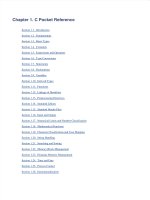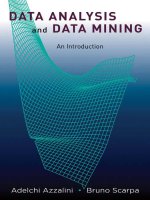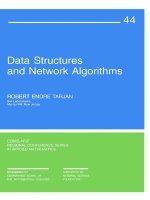IT training presentation LDAP and OpenLDAP
Bạn đang xem bản rút gọn của tài liệu. Xem và tải ngay bản đầy đủ của tài liệu tại đây (14.2 MB, 508 trang )
LDAP and
OpenLDAP
(on the Linux Platform)
March 21, 2003
Copyright
© 2001 Adam Tauno Williams ()
Permission is granted to copy, distribute and/or modify this
document under the terms of the GNU Free Documentation
License, Version 1.1 or any later version published by the Free
Software Foundation with no Invariant Sections, no Front-Cover
Texts, and no Back-Cover Texts. You may obtain a copy of the
GNU Free Documentation License from the Free Software
Foundation by visiting their Web site or by writing to: Free
Software Foundation, Inc., 59 Temple Place - Suite 330, Boston,
MA 02111-1307, USA.
If you find this document useful or further its distribution, we would
appreciate you letting us know.
KLUG
The master copy of this document is hosted by the Kalamazoo
Linux User's Group at the following URL:
/>This document is updated periodically with additional information.
If you have a topic you think this presentation should include please
contact the maintainer:
KLUG's home page can be found at:
See their Past Presentations section for great presentations on a wide
range of Open Source related topics.
Home Page
The home page for this presentations is found at:
/>This is also the home page for the following LDAP related utilities:
ldap2nis
getuidattr
pppd-ldap
KLUG hosts a announcement maillist concerning updates, changes, and
releases of the above projects and this presentation. This is a low traffic
announcement only mail list. A link to the subscription form is available
from the “Mail List” section of this presentation's home page.
There is also a link to my Amazon Wish List on the page, should anyone
feel the need to express their opinion of the utility of this document in a
Versions
For the most part this document assumes OpenLDAP 2.0.x, and most
testing has been done with versions between 2.0.21 and 2.0.25. Slides
containing information specifically relevant to other versions will be
marked with the following symbols:
>2.1.x
Indicates information relevant to OpenLDAP
versions 2.1.x and greater. 2.1.x is the developement
branch after 2.0.x that will become the next stable
release when it is viewed as more stable than 2.0.x
=1.x.x
Indicates information relevant to OpenLDAP
versions prior to release of the 2.0.x series. The
1.x.x series is obselete.
LDAP
(Basics)
What is LDAP?
A cross platform protocol for communicating with a directory
server
A descendent of X.500 OSI Directory Access Protocol, which
was deemed too complex and cumbersome to be implemented
on microcomputers
A data-representation model optimized for arbitrary queries
Recent versions of LDAP also specify encryption methods,
methods for clients to discover the structure of the system's
configuration, as well interoperability with other services such
as Kerberos and SASL.
What is a directory?
A directory is a hierarchical collection of objects and the
attributes of the objects much like the subdirectories of a
filesystem and the files contained in the subdirectories.
A directory is not a database. Objects can have varying
attributes and numbers of the same attributes, unlike the
columnar structure of an SQL database's "table".
Directory servers are typically optimized for a very high
ratio of searches to updates.
What does a directory look
like?
Base Style
Base
o=Foo, c=US (X.500)
dc=foo.com
dc=foo, dc=com (RFC2247)
dc=whitemice, dc=org
Organizational Unit - used to create
an organized hierarchal structure
ou=Groups,dc=whitemice, dc=org
ou=People,dc=whitemice, dc=org
cn=Adam Williams,ou=People,dc=whitemice, dc=org
What does an object look like?
Distinguished Name (dn)
Attribute
dn: cn=Adam Williams,ou=People,dc=whitemice,dc=org
Value
uid: awilliam
cn: Adam Williams
givenName: Adam
sn: Williams
mail:
objectClass: person
objectClass: organizationalPerson
objectClass: inetOrgPerson
objectClass: account
objectClass: posixAccount
objectClass: top
objectClass: kerberosSecurityObject
The values of an object's objectclass
userPassword:: e2NyeXB0fUNwLktlUi9vdG55UUU=
attributes are used to enforce the
krbName:
schema: what attributes an object
loginShell: /bin/bash
should have or is allowed to have.
uidNumber: 500
Why?
Directories offer many benefits over traditional "flat file" name spaces.
Administrative authority is more granular.
Configuration is not host-specific.
Replication increases availability.
For large sites, a directory may be faster than flat files.
Schema enforcement offers some protection against
administrator typos and other syntactical errors.
Requirements
An LDAPv3 compliant directory server*
Functioning DNS, including reverse look ups
Reasonable time synchronization
* This presentation assumes OpenLDAP 2.0.7 ()
The Advantages of LDAP v3
over LDAPv2
Vastly more powerful schema specification
Schema discovery
Server side referrals (Super and Subordinate Knowledge)
The SSL/TLS mechanism offers start to finish encryption of
all communication. With LDAP v2, all communication is in
clear text.
SASL provides automated and secure modular authentication
permitting single-sign-on configurations and making it much more
difficult to spoof connections. With LDAP v2, master and slaves
"trust" each other.
Objects can be renamed in an LDAP v3 directory. In an LDAP
v2 directory, they had to be copied to their new DN and the old
Gotcha: “requested protocol
version not allowed”
Some later version of OpenLDAP (2.1.x) may refuse LDAP version 2
requests by default, and OpenLDAP 2.0.x can be configued to behave
in such a way.
If you receive the error ''requested protocol version not allowed'' from
an application or service it is probably attempting to use LDAPv2
with a DSA that is only accepting LDAPv3 clients. Either upgrade
the application or service, or enable LDAPv2 on the DSA (see allow
bind_v2).
Directory Terms
Base represents the "root" of the directory. The search base
of a query determines where in the directory a search commences.
dc=Whitemice, dc=Org
Scope (base, one, sub) determines how the query descends through
the tree. A base search does not descend below the base level; a
search type of one descends one level; and a search type of sub
freely descends the directory.
Distinguished Name (DN) is the unique identifier for an object, it
is comprised of the base of the object and an attribute that makes it
unique in the context of that base.
cn=Adam Williams, ou=People, dc=Whitemice, dc=Org
Relative Distinguished Name (RDN) is attribute of the DN which
makes the object unique in its context.
Multi-Valued RDNs
While most objects have a single values RDN (cn=Adam Williams) it is
also possible for an object to have a multivalued RDN, where multiple
attributes are compised to make the object unique (much like a composite
primary key in a relational database system).
The attributes of a multi-values RDN are combined using the addition
sign: cn=Adam Williams+relatedDomain=whitemice.org,ou=People,...
Some DSA packages will reorder the elements of the RDN when the
object is stored, this is acceptable as the order of the elements is
irrelevant.
OpenLDAP in particular will sort the attributes of an RDN to be in
alphabetical ascending order.
RDN & The Data Model
The RDNs declared in DN must correspond to attributes within the
object.
An object with a DN of cn=Adam
must have a cn attribute of
“Adam Williams” and the cn attribute cannot be modified to another
value.
Williams,ou=People,dc=Whitemice,dc=Org
OpenLDAP only enforces this requirement in versions 2.1.14 and
later. Versions prior to 2.1.14 permit the creation of technically
incorrect objects within the Dit.
LDAP
(Schema)
Schema
A directory has a schema similar to the schema of a relational
database system.
The schema defines valid object classes, what attributes they
may or must contain, as well as the type of data (strings,
numbers) that a given attribute can contain.
Attribute and Objectclass names should be GLOBALLY unique.
Schemas also determine
how comparisons to an
attribute's contents are
performed (case sensitive
and case insensitive).
What is an OID?
Every schema element is identified by a GLOBALLY unique
string of integers (the OID). OIDs are used by SNMP and other
protocols as well.
If you wish to create schemas (attributes or objectclasses), you
must obtain an OID. Possessing an OID will allow you to
create as many schema extensions as you wish.
You can obtain an OID for free from IANA using the form at:
/>
Resist the temptation to make up your own OID.
1.1.x
It is true that the 1.1.x OID hierarchy has been derelict for some time.
It was originally intended that a number registration authorities would
be rooted at this point on the OID tree, but no such authority was ever
created.
The result is that it may be safe to use this OID for expirimentational
schemas, training, etc....
ASN however can reassign this OID or authorize a registration
authority at their own discretion.
If you are going to design schema that will be in use for any significant
period of time it is still neccesary to aquire an OID specific to your
organization; do not depend on the perpetual dereliction of 1.1.x.
ObjectClass Types
Structural- A structural objectclass defines the basic
characteristics of an object. A given object
should have exactly one structural object class. Examples
of structural objectclasses are person and
groupofuniquenames. It would not make sense for an object
to be both a person and a groupofuniquenames.
Auxiliary - An auxiliary objectclass is additive. It supplements
the attributes of the object's structural class. Most
objectclasses are auxiliary. Examples of auxiliary
objectclasses are strongAuthenticationUser or
pilotPerson. These extend the structural
person objectclass or one if its descendants.
Abstract - Abstract objectclasses are used only to define the
basic LDAP data model, such as top and alias.
Object Schema
OID
Description
Parent
Object
Name
(Alias for OID)
objectclass ( 1.1.2.2.2 NAME 'myPerson'
DESC 'my person'
SUP inetOrgPerson
MUST ( myUniqueName $ givenName )
MAY myPhoto )
An objectclass inherits
all required and allowed
attributes of its parent.
Allowed
Attributes
Required
Attributes
objectclass ( 1.3.6.1.1.1.2.0 NAME 'posixAccount' SUP top AUXILIARY
DESC 'Abstraction of an account with POSIX attributes'
MUST ( cn $ uid $ uidNumber $ gidNumber $ homeDirectory )
MAY ( userPassword $ loginShell $ gecos $ description ) )
WARNING
(Object Class Type)
Early OpenLDAP 2.0.x versions, and none of the 1.x.x versions,
enforce the single structural objectclass entry rule!
This permits the adminstrator to store data within an OpenLDAP DSA
thay violates a fundamental principle of the LDAP data model!
To enable additional features requires implementation of more of the
LDAP data model's constraints. One should expect future versions of
OpenLDAP to enforce this directive, so watch your data carefully,
partiticularly how your extend schema.
Objectclasses with a superior (SUP) clause should be auxiliary not
structural. Use of a structural objectclass definition should be used only
when the objectclass defines something wholly new (something that cannot
Attribute Schema
OID
Name (alias for OID)
Textual
Description
attributetype ( 1.3.6.1.1.1.1.0 NAME 'uidNumber'
DESC 'An integer uniquely identifying a user in an administrative domain'
EQUALITY integerMatch
SYNTAX 1.3.6.1.4.1.1466.115.121.1.27 SINGLE-VALUE )
Match Type
EQUALITY
ORDERING
SUBSTR
Match Type
Qualifier
Syntax OID
Qualifier
SINGLE-VALUE
COLLECTIVE
{LENGTH}









